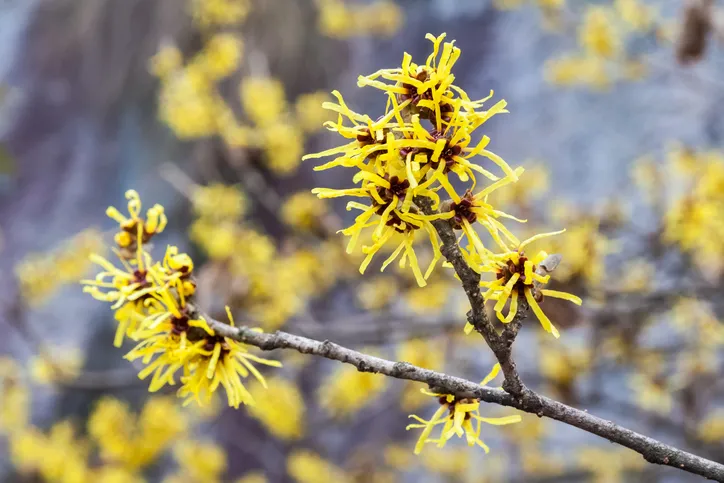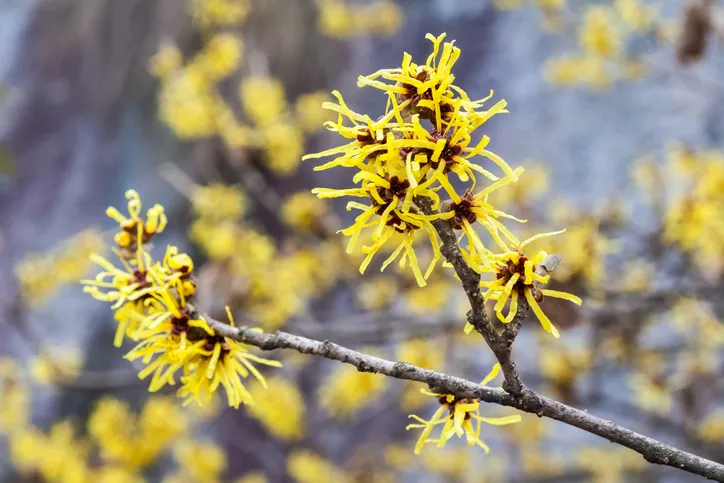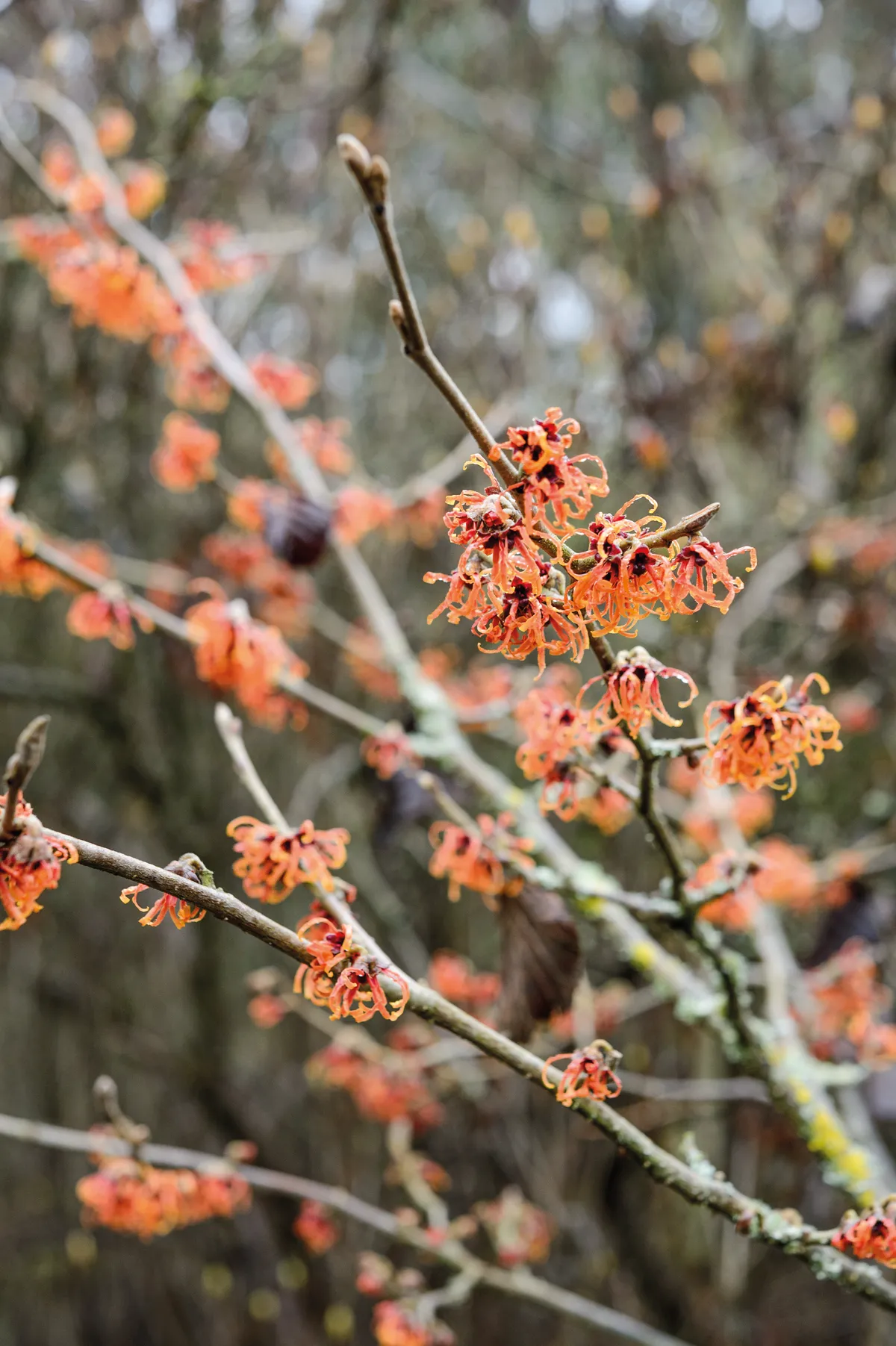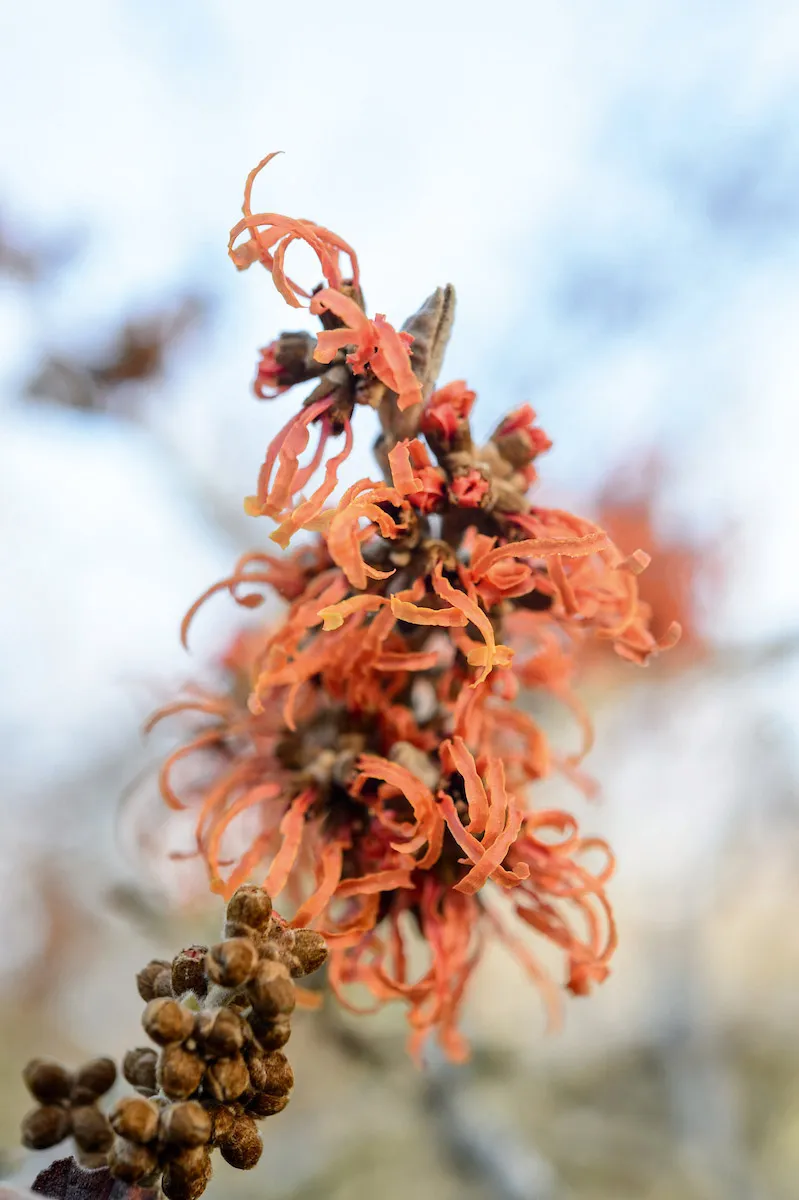Hamamelis, commonly known as witch hazel, is a deciduous shrub which reaches its colourful flowering peak in winter. The unusual, citrus-scented, spidery blossoms appear like flames along the bare branches at the coldest time of year, from December to February and March.
The petals resemble the peel left behind by an orange zester and, although fragile looking, these winter flowers are hardy and long-lasting.
Planted in groups among carpets of snowdrops, hellebores and winter aconites, they have become an indispensable element of winter gardens. Isolated specimens, too, can look impressive. These plants are slow growers but will eventually reach up to 5m tall.
How to grow Hamamelis or witch hazel

- Soil: Hamamelis are easy shrubs to grow and should do well in most gardens, except those that are on shallow, chalk soil. The ideal is an acid to neutral soil (a pH of between 4.5 and 6.5) that is well drained, although I know gardens with a higher pH that have magnificent specimens of Hamamelis mollis. If they become chlorotic because of a high pH, treat them with chelated iron. (Chlorosis is a condition where the plant produces insufficient chlorophyll, resulting in yellow leaves.)
- Light: For a rounded, compact shrub, grow in an open sunny situation. Hamamelis will grow in shade but develop long shoots that make for a gangly-looking plant. Although the flowers are tough, the young foliage can be burned by strong winds, so plant somewhere sheltered.
- Moisture: Whatever the soil, dig in lots of organic matter. This will feed the plant and retain moisture. Although mature plants will tolerate periods of drought, young plants should be kept well watered during hot summers.
How to prune Hamamelis
If you have the space to let Hamamelis grow to their full size they need little pruning other than to take out dead wood. When you need to keep the shrub to a manageable size, prune it after flowering by cutting back that season’s growth to a leaf bud. You can distinguish between leaf and flower buds by the longer, narrow shape of the leaf buds, while flower buds are round and fat.
How to grow Hamamelis in pots & containers
In small gardens, consider growing Hamamelis in pots, which will severely restrict the size they will reach. Choose a pot at least 50cm in diameter and use a John Innes or other soil-based ericaceous compost. Keep the pot well watered during the summer and stand on pot feet so that water can drain away during the winter. Most Hamamelis cultivars are grafted on to a vigorous rootstock that will produce suckers if planted too deeply. Try not to bury the graft joint (the swollen part of the stem near the base of the plant).
Best Hamamelis cultivars to grow
Yellow-flowered witch hazels
Hamamelis mollis
The best of the species, with strongly perfumed flowers. In autumn the pale green foliage melts to a soft, buttery yellow. Slow growing, it will take 20 years to reach full height. 4m. RHS H7, USDA 5a-8b.

Hamamelis x intermedia ‘Pallida’
Popular for both for its penetrating perfume and the masses of pale-yellow flowers that have a ghostly glow at twilight, this is perhaps the most widely available hamamelis. 3m. AGM. RHS H5, USDA 5a-8b.
Hamamelis mollis ‘Wisley Supreme'
The clear, yellow flowers are sweetly scented and begin to appear as early as November. The autumn foliage is bright yellow. The shrub spreads with age, eventually becoming 3m wide. 3m. AGM. RHS H5, USDA 5a-8b.
Hamamelis mollis ‘Imperialis’
Its strongly scented flowers are perhaps the largest of the genus. They’re pale yellow with a red tint at the base of the petals. Young plants have sparse flowers, increasing as the plant matures. 3m. RHS H7, USDA 5a-8b.

Hamamelis x intermedia ‘Arnold Promise’
Forms a much denser shrub than other hamamelis and so appears to be a thicket of flowers, which have a very strong, sweet scent. Eventually forms a vase-shaped shrub. 3m. AGM. RHS H5, USDA 5a-9b.
Orange witch hazels
Hamamelis japonica ‘Rubra’
A tough and vigorous clone that forms a rounded shrub. It was selected by a French nursery a century ago for its red flowers and has been used extensively in breeding new cultivars. 3m. RHS H7, USDA 4a-9a.
Hamamelis virginiana
Fast growing, it quickly reaches 3m tall. The flowers start to appear during autumn and are at their peak in midwinter. Not a showy plant but the flowers can be a beautiful adjunct to autumn foliage. 3m. RHS H7, USDA 3a-9b.

Hamamelis x intermedia ‘Jelena’
Named in the 1950s by plant breeder Robert de Belder for his wife, this is one of the most widely grown hamamelis. Although it has little scent, the warm brass-coloured flowers are enchanting. 4m. AGM. RHS H5, USDA 5a-9b.
Hamamelis x intermedia ‘Aphrodite’
A spreading shrub that will eventually grow to 4m wide and about 3m tall. The burnt-orange flowers represented an important colour break for breeders when the plant appeared during the 1980s. 3m. AGM. RHS H7, USDA 5a-9b.
Hamamelis x intermedia ‘Orange Peel’
Its sweetly scented flowers have wider petals than most, giving the impression of a small pom-pom. Autumn foliage is as spectacular as the flowers, encompassing tones of red, orange and yellow. 3m. RHS H7, USDA 5a-8b.
Red witch hazels

Hamamelis x intermedia ‘Robert’
Introduced in 2000, this is an outstanding cultivar with very sweetly perfumed flowers. The individual petals fade from red to copper, which gives a warm and glowing effect to the whole plant. 3.5m. AGM. RHS H7, USDA 5a-9b†.
Hamamelis x intermedia ‘Rubin’
A rounded plant with flowers that have little scent but are produced profusely from December to the end of February. Its leaves become a fiery orange in autumn. 4m. RHS H7, USDA 5a-9b.
Hamamelis x intermedia ‘Livia’
Bred only 20 years ago this cultivar must have the most intensely red flowers of the genus. The flowers have a spicy perfume and grow in profusion from December through to March. 3.5m. RHS H7, USDA 5b.
Hamamelis x intermedia ‘Feuerzauber’
A vigorous hybrid that grows quickly and has a 3m-wide spread. The coppery-orange flowers are produced in abundance but have very little perfume. Sometimes sold as Hamamelis x intermedia ‘Firecracker’. 3.5m. RHS H7, USDA 6a-9b.
Hamamelis vernalis ‘Lombarts’ Weeping’
An unusual cultivar with small flowers and spreading habit with pendulous branches. It will only reach 2m tall but as much as 4m wide. The flowers, which continue into March, have a strong spicy scent. 2m. RHS H7, USDA 4a.
Hamamelis x intermedia ‘Diane’
Named after his daughter by prolific hamamelis breeder Robert de Belder who believed this to be the best of the red-flowered forms. In the autumn the foliage turns through maroon and crimson to flaming orange. 2.5m. AGM. RHS H5, USDA 5a-9b.
Where to see witch hazel
National Collections of Hamamelis can be visited at:
Sir Harold Hillier Gardens
Jermyns Lane,
Romsey,
Hampshire SO51 0QA.
Tel 01794 369317/318
Witch Hazel Nursery
The Granary,
Cranbrook Farm,
Callaways Lane,
Newington,
Sittingbourne,
Kent ME9 7LU.
Tel 01795 843098
Where to buy witch hazel
Bluebell Arboretum and Nursery
Annwell Lane,
Smisby,
nr Ashby de la Zouch,
Derbyshire LE65 2TA.
Tel 01530 413700
Junker’s Nursery
Higher Cobhay,
Milverton,
Somerset TA4 1NJ.
Tel 01823 400075